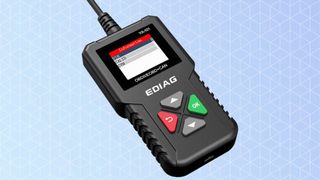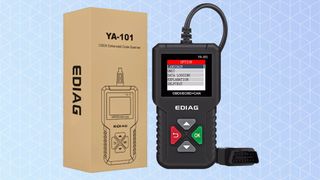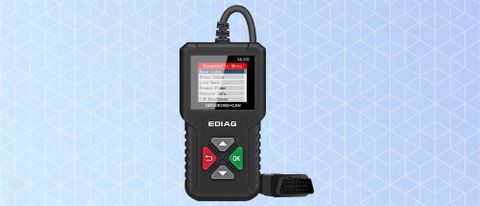Tom's Guide Verdict
Small, light, and inexpensive, the EDiag YA-101 OBD-II automotive scanner offers a wide array of diagnostic functions plus a battery-test sequence, firmware updates and a lifetime warranty.
Pros
- +
Excellent basic scanner
- +
Battery test
- +
Lifetime warranty and updates
Cons
- -
Limited four-key interface
- -
Lacks high-end features
Why you can trust Tom's Guide
Size: 4.8 x 2.6 x 0.9 inches
Weight: 6.1 ounces
Live data: Yes
Display type and size: Color, 1.8 inches
Number of keys: 4
Bluetooth: No
Handheld: Yes
Warranty: Lifetime
It may lack the detailed diagnostic routines that other OBD-II scanners have, but at $25, the EDiag YA-101 is an excellent bargain that deserves a place on the list of best OBD-II scanners. Its built-in battery-test routine, lifetime warranty and extended firmware updates make it an automotive cheapskate's dream come true.
Read on for the rest of our EDiag YA-101 review.
EDiag YA-101 Pricing and availability
Priced at $23, the EDiag YA-101 is among the least expensive OBD-II scanners available, but this is not a cheap device that's limited to a monochrome screen and few abilities. Instead, it's got a full-color screen and a lot to offer.
There is a more expensive model, the $60 EDiag YA-301, which adds three more interface keys and the ability to graph live data, but the YA-101 is far from the bottom of the barrel.
EDiag YA-101 Design
One of the smallest handheld OBD-II scanners available, the EDiag YA-101 is also among the best entry-level automotive diagnostic devices. At 4.8 x 2.6 x 0.9 inches and 6.1 ounces, the YA-101 is about half as big as, and a lot easier to carry than, the massive Innova CarScan Inpector 5310. In other words, the YA-101 should easily fit in a car's center console or a toolbox.

The YA-101's black finish has ribbed hand grips, but the scanner has a hollow feel to it that makes it seem like it wouldn't survive an abusive relationship with a clumsy mechanic.
Its 1.8-inch screen falls short in real estate compared to the Car Scan 5310's 2.8-inch display, and the EDiag YA-101's text-based navigation scheme isn't as obvious as the more visually oriented icon-based systems.
While its four-key interface has soft silicone keys that are color-coded with a green OK key and a red "Go Back" button, the YA-101 can be frustrating to use. Compared to scanners that have more keys, the EDiag YA-101 leaves a lot to be desired, and some selections take an extra keystroke or two to get what you want.
There's an old-school mini-USB port at the bottom of the YA-101 for updating its firmware, but there's no USB cable for that port in the package. You might have to go online to find a compatible cable, as mini-USB-to-USB-A plugs haven't been widely used since about 2010.
The YA-101 goes beyond rudimentary on-board diagnostics. Along with detecting engine misfires, the small scanner squeezes in analysis of potential battery and charging problems.
It can check on the oxygen sensor and run an I/M pre-inspection readiness test (a good indicator of whether your car will pass a smog check), but the YA-101 lacks the red, yellow and green LED lights that telegraph the results on some other scanners.

The YA-101 can show live car data for a large variety of parameters, but the results are displayed in a tabular format. The YA-101's slightly more expensive cousin, the YA-301, can graph the data for greater visual impact and analytical appeal.
EDiag YA-101 Performance
After I plugged in the YA-101 and fired up a vehicle, the scanner quickly connected with the computers on my 2014 Audi A4 AllRoad and 2016 Infiniti Q50. It was able to show the vehicle identification number (VIN) for each vehicle.
I manually disconnected the oil-temperature sensor on my 2014 Audi AllRoad, and the YA-101 detected the fault and then let me turn off the Check Engine light. On the downside, the YA-101 was not advanced enough to turn off the oil light after I drained the oil and replaced the oil and filter.
The scanner was able to show me that the car's battery and charging system were OK, but when something was amiss, the YA-101 could show me only the fault code.
In other words, the EDiag lacks any sort of explanation of the fault, suggestions for repair or links to the needed parts. Larger, more expensive scanners, including the Innova CarScan Inspector 5310, do provide those features. Still, the EDiag YA-101 is a good small scanner to have on hand.

EDiag YA-101 Setup
The YA-101's permanently attached OBD-II cable is skimpy at 32 inches. It's just long enough to reach the OBD-II port if you're sitting in the driver's seat of most cars. In other words, you won't be able to use the EDiag YA-101 while you're poking around the engine bay. An OBD extension cable is a must-have accessory for this scanner.

The best part just might be EDiag's lifetime warranty for the YA-101 model. This means that the company will provide firmware updates as needed over the years, making it an OBD-II scanner that's cheap to keep up.
EDiag YA-101 Verdict
A marvel of miniaturization, the EDiag YA-101 OBD-II automotive diagnostic scanner does a lot with a little, as far as its size and unbeatable $23 price tag go. Its four-key interface might be inefficient, but the YA-101 comes with a lifetime warranty and software upgrades, making it a scanner that will keep helping you regardless of your ride.
Brian Nadel is a freelance writer and editor who specializes in technology reporting and reviewing. He works out of the suburban New York City area and has covered topics from nuclear power plants and Wi-Fi routers to cars and tablets. The former editor-in-chief of Mobile Computing and Communications, Nadel is the recipient of the TransPacific Writing Award.


